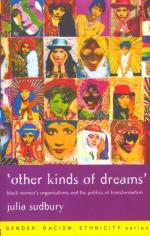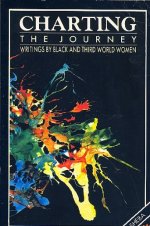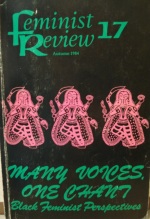Writing in the early twenty-first century, in an article exploring the possibilities of a third wave black feminism, Kimberly Springer outlined how the “wave model” in its dominant form drowns out the activism of black women. Writing about the US context, Springer pointed out how the dominant understandings of the 1st wave (suffrage movement), 2nd wave (women’s liberation/women’s rights movements in 60s-70s) and 3rd wave (contemporary feminism) “disregard[ed] the race-based movements before them that served as precursors, or windows of political opportunity, for gender activism” (Springer 2002: 1061). For example, the dominant third wave narrative, she pointed out, tends to dismiss the role of black women in the development of the term itself – noting that Kitchen Table Women of Color Press had plans to publish a book in the late 1980s called ‘The Third Wave’. The book, which unfortunately never came to fruition, “was to describe an antiracist, women-of-color-led feminism for the coming decade” (Springer 1063).
Springer’s critique of the wave model is relevant for thinking also about feminism in Britain. Although following its own unique trajectory, located in a different social and historical context, the wave story here is often told in similar terms: First wave = movements for suffrage, including the suffragettes; second wave = the Women’s Liberation Movement in the 70s. What exactly constitutes the third – and potentially a fourth – wave is perhaps the most disputed. But whatever the definitions, similar to the US version, the wave story seldom accounts for black women’s theory and activism.
I was reminded of Springer’s article this week apropos the New Stateman’s “Rereading the second wave”, a series of posts on so-called ‘second wave’ feminists and their work. Ten out of eleven of the feminists in question are/were white, with only one post about a feminist of colour (Audre Lorde). Now my post is not so much about the NS series in itself. It is after all a rather idiosynchratic list chosen by a group of feminists assembled by the NS and, as the introductory post states, it’s not meant to be definitive – although note the regularity with which this claim is used as a get-out clause when systemic exclusions are pointed out. Aside from the lack of feminists of colour, what stands out to me most is that eight of the so-called ‘second wave’ feminists are/were American (none British). I also wonder how Judith Butler feels about being described as ‘second wave’, but whatever.
What I am interested in is how stories of feminism get told – both within the liberal (in some senses) ‘pro-feminist’ media such as the New Statesman and the Guardian, as well as among contemporary feminists themselves (and these of course overlap) – and how those stories are inflected and defined by white supremacy. I mean, considering the NS list is so idiosynchratic, then why is it still so white? Of course there is a straight-forward, predictable answer to this: most of the contributors to the series are white. But leaving that to one side for a moment – although it is of course part of the problem – is there something inherent in the ‘second wave’ terminology that denotes whiteness? As Springer observed, “The wave model perpetuates the exclusion of women of color from women’s movement history and feminist theorizing” (1063) and this certainly is the overwhelming case when looking at invocations of the “second wave” within many British feminist spaces. It seems to limit the imagination of what histories of women’s activism look like, because the dominant image associated with “second wave” activism is that of white women’s liberationists.
Although she is critical of the ‘wave model’, Springer argues that because it is so embedded within our understandings of feminism, it is still worth working with this model – critiquing it from within and expanding it to include women of colour’s activism (the bulk of her article focuses on the possibilities of a third wave black feminism and how it might engage with more young black women). But others write without using the wave metaphor. Julia Sudbury, for example, in her book on (politically) black women’s activism in post-war Britain does not refer to waves at all – the stories simply don’t fit that way. Neither is her research framed exclusively around the term feminism (Sudbury locates herself as writing from a Womanist perspective). The fact that many black women have organised for rights and justice without taking on the label ‘feminist’ also needs to be recognised as part of the complexity of women’s activist & feminist histories.
But the wave metaphor is very pervasive within Anglo-American feminist storytelling. Personally, I’m quite averse to using it in my own writing, yet find it difficult to get completely away from doing so. So is Springer right? Is it better to try and work with the wave model, but to critique it and expand it? Or is “second wave” irrevocably bound to the image of a white women? (and this is a two-way process – I often see and hear ‘second wave’ used as derogatory short-hand for white feminism).
Either way, what is undoubtedly urgent is the need to destabilize the hegemonic whiteness of stories of the feminist past as they are told and re-told within contemporary feminist spaces.
I started writing a whole other part to this post about structural racism, capitalism and publishing, which of course plays a huge role in who gets to write books and become canonised. But I’ll leave that for now, because it’s a somewhat separate point. After all, women of colour did publish extensively in the 1970s and 80s (often collectively through anthologies). Their continued marginalisation from the dominant feminist canon of this time period is not because they weren’t writing, but because of white supremacy.
So if you are unfamiliar with the histories of scholarship by women of colour and black feminists in the 70s, 80s and 90s, here are a few of my suggestions (with a focus on Britain) of writings to seek out:
‘Other kinds of dreams’: Black women’s organisations and the politics of transformation, by Julia Sudbury (Routledge 1998). Sudbury’s PhD thesis on which this book is based on is available open access from Warwick University’s online repository.
Black British Feminism: A Reader, edited by Heidi Safia Mirza (Routledge 1997).
Charting the Journey: Writings by Black and Third World Women, edited by Shabnam Grewal, Jackie Kay, Liliane Landor, Gail Lewis and Pratibha Parmar (Sheba Feminist Press 1988). Also: Listen to Gail Lewis talking about how this book was marginalised within British Women’s Studies programmes on the Sisterhood and After online archive.
Finding a Voice: Asian Women in Britain, by Amrit Wilson (Virago Press 1978). You can listen to Amrit Wilson talking about researching this book on the Sisterhood and After online archive. See also Wilson’s more recent Dreams, Questions, Struggles: South Asian Women in Britain (Pluto Press 2006).
Cartographies of Diaspora; Contesting Identities, by Avtar Brah (Routledge 1996).
Feminist Review issue 17: ‘Many Voices, One Chant: Black Feminist Perspectives’ (1984). This might be tricky to get hold of outside of academic libraries (there are also copies in the Feminist Library in London), but you can read Valerie Amos and Pratibha Parmar’s influential essay “Challenging imperial feminism” online [PDF link].



